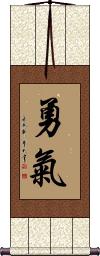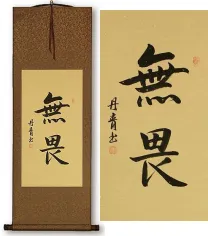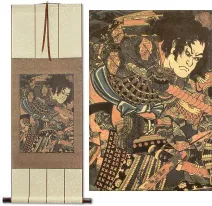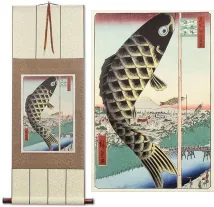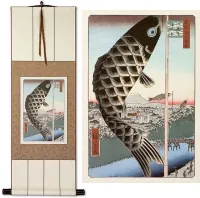Many custom options...
And formats...

Not what you want?
Try other similar-meaning words, fewer words, or just one word.
No Yong in Chinese / Japanese...
Buy a No Yong calligraphy wall scroll here!
Personalize your custom “No Yong” project by clicking the button next to your favorite “No Yong” title below...
Bravery / Courage
Courageous Energy
勇氣 is one of several ways to express bravery and courage in Chinese, Japanese, and Korean.
This version is the most spiritual. This is the essence of bravery from deep within your being. This is the mental state of being brave versus actual brave behavior. You'd more likely use this to say, “He is very courageous,” rather than “He fought courageously in the battle.”
The first character also means bravery or courage when it's seen alone. With the second character added, an element of energy or spirit is added. The second character is the same “chi” or “qi” energy that Kung Fu masters focus on when they strike. For this reason, you could say this means “spirit of courage” or “brave spirit.”
This is certainly a stronger word than just the first character alone.
Beyond bravery or courage, dictionaries also translate this word as valor/valour, nerve, audacity, daring, pluck, plucky, gallantry, guts, gutsy, and boldness.
This is also one of the 8 key concepts of tang soo do.
![]() While the version shown to the left is commonly used in Chinese and Korean Hanja (and ancient Japanese Kanji), please note that the second character is written with slightly fewer strokes in modern Japanese. If you want the modern Japanese version, please click on the character to the right. Both styles would be understood by native Chinese, Japanese, and many (but not all) Korean people. You should make your selection based on the intended audience for your calligraphy artwork. Or pick the single-character form of bravery/courage which is universal.
While the version shown to the left is commonly used in Chinese and Korean Hanja (and ancient Japanese Kanji), please note that the second character is written with slightly fewer strokes in modern Japanese. If you want the modern Japanese version, please click on the character to the right. Both styles would be understood by native Chinese, Japanese, and many (but not all) Korean people. You should make your selection based on the intended audience for your calligraphy artwork. Or pick the single-character form of bravery/courage which is universal.
Drain the pond to get all the fish
Kill the goose that lays the golden eggs
In 632 BC, Duke Wen of the Kingdom of Jin was about to lead an army against the forces of the Kingdom of Chu.
The Duke asked one of his advisers, Jiu Fan, how they could win the impending battle, as they were drastically outnumbered.
Jiu Fan said, “All is fair in war,” and suggested a plan of dishonorable tactics (cheating).
The Duke was unsure of this advice, so he asked another adviser, Yong Ji, who replied, “If you catch fish by draining the pond, you can certainly get all the fish. But there will be no fish the following year. You can cheat this one time in battle, but such tactics can only be used once, as the enemy will be wise in future encounters.”
The Duke heard the words of his wiser adviser but cheated to gain victory in the battle. However, he rewarded Yong Ji more than Jiu Fan at the victory celebration, stating that while Jiu Fan's advice gained one victory, the wise words of Yong Ji would last forever.
This Chinese idiom/proverb is still used, over 2600 years later to remind people not to burn bridges, cheat, or dishonor themselves in exchange for a short-term gain while sacrificing the future.
竭澤而漁 is very similar to the meaning of the English phrase, “Kill the goose that lays the golden eggs.”
Wing Chun Fist Maxims
Wing Chun Kuen Kuit
This text is the chant or poem of Wing Chun.
I call it a “chant” because it was meant to be a somewhat rhythmic poem to help practitioners memorize many aspects of Wing Chun.
1 有手黐手,無手問手
2 來留區送, 甩手直沖
3 怕打終歸打, 貪打終被打
4 粘連迫攻, 絕不放鬆
5 來力瀉力, 借力出擊
6 步步追形, 點點朝午
7 以形補手, 敗形不敗馬
8 腰馬一致, 心意合一
9 拳由心發, 動法無形
10 活人練活死功夫
You will see this referred to as “Wing Chun Kuem Kuit.” This Cantonese romanization is popular in the west (and there is no official way to romanize Cantonese, so many variations exist). In Mandarin, it would be, “Yong Chun Quan Jue.” The last character (kuit or kyut from Cantonese, jue or chüeh from Mandarin) kind of means “secrets of the art.” It's a short way to write 口訣, meaning “mnemonic chant” or “rhyme for remembering.”
In the west (especially in the military), we often use acronyms to remember things. There are no initials to make acronyms in Chinese, so in ancient times, chants like this are used to remember vast amounts of information.
I will presume you already know the meaning of the 10 maxims, so I will skip that to keep this calligraphy entry from getting too large.
Some think 练拳者必记 is the title but that just says, “(When) training (the) fist, people should remember:.” Therefore, I've not included that in the calligraphy. However, you can put a note in the special instructions if you want it added.
Note: On a traditional calligraphy wall scroll, the characters will be written in vertical columns, starting from the right, and proceeding left.
Note: This is an except and variation from a huge 口訣. These 10 maxims are used extensively in Wing Chun training, and you’ll find them all over the internet. Just know there is a much longer version out there, along with several variations and excepts like this one. If you know of, or want a different version, just contact me, and I will add it for you.
This in-stock artwork might be what you are looking for, and ships right away...
Gallery Price: $108.00
Your Price: $59.88
Gallery Price: $108.00
Your Price: $59.88
Gallery Price: $61.00
Your Price: $33.88
Gallery Price: $61.00
Your Price: $33.88
Gallery Price: $61.00
Your Price: $33.88
Gallery Price: $61.00
Your Price: $33.88
Gallery Price: $61.00
Your Price: $33.88
Gallery Price: $108.00
Your Price: $59.88
Gallery Price: $90.00
Your Price: $49.88
Not the results for no yong that you were looking for?
Below are some entries from our dictionary that may match your no yong search...
| Characters If shown, 2nd row is Simp. Chinese |
Pronunciation Romanization |
Simple Dictionary Definition |
勒 see styles |
lēi lei1 lei roku ろく |
More info & calligraphy: Le(1) bit (horse mouthpiece); (2) (See 永字八法) second stroke in the Eight Principles of Yong; rightward stroke Rein; extort, force; a left stroke; to draw in. |
側 侧 see styles |
zhāi zhai1 chai soku そく |
lean on one side (See 永字八法) first principle of the Eight Principles of Yong; tiny dash or speck; (surname) Soba lean to one side |
啄 see styles |
zhuó zhuo2 cho taku たく |
to peck (See 永字八法) seventh principle of the Eight Principles of Yong; stroke that falls leftwards with slight curve; (given name) Taku |
掠 see styles |
lüè lu:e4 lu:e ryaku りゃく |
to take over by force; to rob; to plunder; to brush over; to skim; to sweep (See 永字八法) sixth principle of the Eight Principles of Yong; tapering thinning curve, usually concave left to rob |
磔 see styles |
zhé zhe2 che taku たく |
old term for the right-falling stroke in Chinese characters (e.g. the last stroke of 大[da4]), now called 捺[na4]; sound made by birds (onom.); (literary) to dismember (form of punishment); to spread (See 永字八法) eighth principle of the Eight Principles of Yong; stroke that falls rightwards and fattens at the bottom |
策 see styles |
cè ce4 ts`e tse saku さく |
policy; plan; scheme; bamboo slip for writing (old); to whip (a horse); to encourage; riding crop with sharp spines (old); essay written for the imperial examinations (old); upward horizontal stroke in calligraphy (n,n-suf) (1) plan; policy; means; measure; stratagem; scheme; (2) (See 永字八法) fifth principle of the Eight Principles of Yong; right upward flick; (male given name) Hakaru A treatise, book, memo, tablet, card; a plan, scheme; question; whip; etc. |
趯 see styles |
yuè yue4 yüeh teki てき |
to jump (See 永字八法) fourth principle of the Eight Principles of Yong; hook at the end of a vertical or horizontal stroke |
鄘 see styles |
yōng yong1 yung |
surname Yong; name of a feudal state |
吳用 吴用 see styles |
wú yòng wu2 yong4 wu yung |
Wu Yong, character of 水滸傳|水浒传[Shui3 hu3 Zhuan4], nicknamed Resourceful Star 智多星[Zhi4 duo1 xing1] |
周顒 周颙 see styles |
zhōu yóng zhou1 yong2 chou yung Shū Gu |
Zhou Yong |
柳永 see styles |
liǔ yǒng liu3 yong3 liu yung |
Liu Yong (987-1053), Song poet |
永安 see styles |
yǒng ān yong3 an1 yung an nagayasu ながやす |
Yong'an, a county-level city in Sanming City 三明市[San1ming2 Shi4], Fujian; Yong'an, the name of numerous other places (surname) Nagayasu |
甬江 see styles |
yǒng jiāng yong3 jiang1 yung chiang |
Yong River in Ningbo 寧波|宁波[Ning2 bo1] |
邵雍 see styles |
shào yōng shao4 yong1 shao yung |
Shao Yong (1011-1077), Northern Song poet and Rationalist scholar 理學家|理学家 |
金庸 see styles |
jīn yōng jin1 yong1 chin yung |
Jin Yong, pen name of Louis Cha (1924-2018), wuxia 武俠|武侠[wu3 xia2] novelist, author of the 1957-1961 Condor Trilogy |
ヤンク see styles |
yangu ヤング |
(can be adjective with の) (1) young; (2) youth; young person; (place-name) Young (Australia); Yang; Yong; Yonge |
ヨン様 see styles |
yonsama ヨンさま |
(person) Bae Yong-joon (nickname) (Korean actor) |
平安道 see styles |
píng ān dào ping2 an1 dao4 p`ing an tao ping an tao |
P'yong'ando Province of Joseon Korea, now divided into South Pyong'an Province 平安南道[Ping2 an1 nan2 dao4] and North Pyong'an Province 平安北道[Ping2 an1 bei3 dao4] of North Korea |
掃地僧 扫地僧 see styles |
sǎo dì sēng sao3 di4 seng1 sao ti seng |
Sweeper Monk, nameless monk who maintains the library of Shaolin (from Jin Yong's novel "Demigods and Semidevils" 天龍八部|天龙八部[Tian1 long2 Ba1 Bu4]); (fig.) person whose remarkable talents are not well known |
永安市 see styles |
yǒng ān shì yong3 an1 shi4 yung an shih |
Yong'an, a county-level city in Sanming City 三明市[San1ming2 Shi4], Fujian |
永安鄉 永安乡 see styles |
yǒng ān xiāng yong3 an1 xiang1 yung an hsiang |
Yong'an or Yung'an township in Kaohsiung county 高雄縣|高雄县[Gao1 xiong2 xian4], southwest Taiwan |
金永南 see styles |
jīn yǒng nán jin1 yong3 nan2 chin yung nan kimuyomunamu きむよむなむ |
Kim Yong-nam (1928-), North Korean politician, foreign minister 1983-1998, president of the Supreme People's Assembly 1998-2019 (nominal head of state and described as deputy leader) (person) Kim Yong-nam (1928.2.4-), President of the Presidium of the Supreme People's Assembly of North Korea |
金英哲 see styles |
kimuyonchoru キムヨンチョル |
(person) Kim Yong-chol (1945-), North Korean general and politician |
韓龍雲 see styles |
hán lóng yún han2 long2 yun2 han lung yün |
Han Yong-un |
天龍八部 天龙八部 see styles |
tiān lóng bā bù tian1 long2 ba1 bu4 t`ien lung pa pu tien lung pa pu tenryū hachibu |
Demigods and Semidevils, wuxia novel by Jin Yong 金庸[Jin1 Yong1] and its TV and screen adaptations devas, nāgas, and others of the eight classes: devas, nāgas, yakṣas, gandharvas, asuras, garuḍas, kinnaras, mahoragas. 天; 龍; 夜叉; 乾闥婆; 阿修羅; 迦樓羅; 堅那羅; 摩睺羅迦. |
平安北道 see styles |
píng ān běi dào ping2 an1 bei3 dao4 p`ing an pei tao ping an pei tao heianhokudou / heanhokudo へいあんほくどう |
North P'yong'an Province in west of North Korea, adjacent to Liaoning (place-name) Heianhokudō |
平安南道 see styles |
píng ān nán dào ping2 an1 nan2 dao4 p`ing an nan tao ping an nan tao |
South P'yong'an Province in west of North Korea |
永字八法 see styles |
eijihappou / ejihappo えいじはっぽう |
(yoji) (so named because all strokes are found in the character 永) Eight Principles of Yong; principles for writing the eight basic brush strokes in Chinese characters |
神鵰俠侶 神雕侠侣 see styles |
shén diāo xiá lǚ shen2 diao1 xia2 lu:3 shen tiao hsia lü |
"The Return of the Condor Heroes" (1959-61 wuxia novel by Jin Yong 金庸[Jin1 Yong1]) |
倚天屠龍記 倚天屠龙记 see styles |
yǐ tiān tú lóng jì yi3 tian1 tu2 long2 ji4 i t`ien t`u lung chi i tien tu lung chi |
Heaven Sword and Dragon Saber, wuxia (武俠|武侠[wu3 xia2], martial arts chivalry) novel by Jin Yong 金庸[Jin1 Yong1] and its screen adaptations |
Click here for more no yong results from our dictionary
The following table may be helpful for those studying Chinese or Japanese...
| Title | Characters | Romaji (Romanized Japanese) | Various forms of Romanized Chinese | |
| Bravery Courage | 勇氣 勇气 / 勇気 | yuuki / yuki | yǒng qì / yong3 qi4 / yong qi / yongqi | yung ch`i / yungchi / yung chi |
| Drain the pond to get all the fish | 竭澤而漁 竭泽而渔 | jié zé ér yú jie2 ze2 er2 yu2 jie ze er yu jiezeeryu | chieh tse erh yü chiehtseerhyü |
|
| Wing Chun Fist Maxims | 有手黐手無手問手來留區送甩手直沖怕打終歸打貪打終被打粘連迫攻絕不放鬆來力瀉力借力出擊步步追形點點朝午以形補手敗形不敗馬腰馬一致心意合一拳由心發動法無形活人練活死功夫 有手黐手无手问手来留区送甩手直冲怕打终归打贪打终被打粘连迫攻绝不放松来力泻力借力出击步步追形点点朝午以形补手败形不败马腰马一致心意合一拳由心发动法无形活人练活死功夫 | |||
| In some entries above you will see that characters have different versions above and below a line. In these cases, the characters above the line are Traditional Chinese, while the ones below are Simplified Chinese. | ||||
Successful Chinese Character and Japanese Kanji calligraphy searches within the last few hours...
